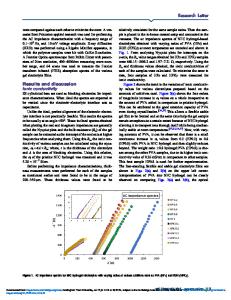Cellulose hydrogel as a flexible gel electrolyte layer
- PDF / 637,819 Bytes
- 7 Pages / 612 x 792 pts (letter) Page_size
- 103 Downloads / 401 Views
Research Letter
Cellulose hydrogel as a flexible gel electrolyte layer Aswani Poosapati, Eunhwa Jang, and Deepa Madan , Department of Mechanical Engineering, University of Maryland, Baltimore County, MD 21250, USA Nathaniel Jang, and Liangbing Hu, Department of Material Science and Engineering, University of Maryland, College Park, MD 20740, USA Yucheng Lan, Department of Physics, Morgan State University, Baltimore, MD 21251, USA Address all correspondence to Deepa Madan at [email protected] (Received 31 October 2018; accepted 11 January 2019)
Abstract We report the synthesis of a novel polymer gel electrolyte primarily based on cellulose extracted from wood along with gelatin, polyacrylic acid (PAA) and potassium hydroxide (KOH) added as additives in minute amounts in various stages. We also study and report the variation of ionic conductivity with variation of various additives. We found that, with variation of additives to hydrogel, its stability and degree of crystallinity are varied. The results were confirmed using x-ray diffraction and Fourier transform infrared spectra studies. An average best ionic conductivity of 96.89mS/cm was reported for a hydrogel: gelatin: PAA: KOH system, which is one of the best reported values of ionic conductivity for gel electrolytes.
Introduction Preparation of an efficient electrolyte layer is one of the most crucial steps in constructing a battery. Electrolyte layer plays a major role because all chemical reactions happen at the electrode–electrolyte interface. They also act as a medium for movement of ions from anode to cathode during discharge and vice-versa during charge cycles, which are monitored using ionic conductivity values. Due to the dependence of battery performance on the electrolyte layer, vast and varied research has been performed for decades. Based on existing research, most flexible batteries use a liquid electrolyte (KOH, NaOH, etc.), which is casted and soaked within the battery. Prolonged dependence on liquid electrolytes with separators for batteries was seen due to the edge obtained from continuous ionic contact between the anode and cathode even when being flexed.[1] But, liquid electrolytes are toxic, corrosive, unsafe, and there is always a danger of leakage if the battery is misused or physically damaged. Additionally, they also have the tendency to form dendrites that progress until contact, due to the repeated recharge cycles and finally cause the battery to fail.[2–5] To avoid manufacturing and packaging complexities and to increase resiliency against extreme conditions such as shock, vibrations, and extreme temperatures, a solid or polymeric electrolyte (ceramics, polymers, etc.) is found to be the best substitute.[6–9] Polymeric electrolytes are also attractive because of their light weight, processing simplicity, and their ease of fabrication.[7] The reduced content of solvent (or no solvent in some cases) also makes them inherently safe. A wide variety of polymers such as polyethylene oxide (PEO), polyvinyl alcohol (PVA), polyacrylonitrile, poly(
Data Loading...











